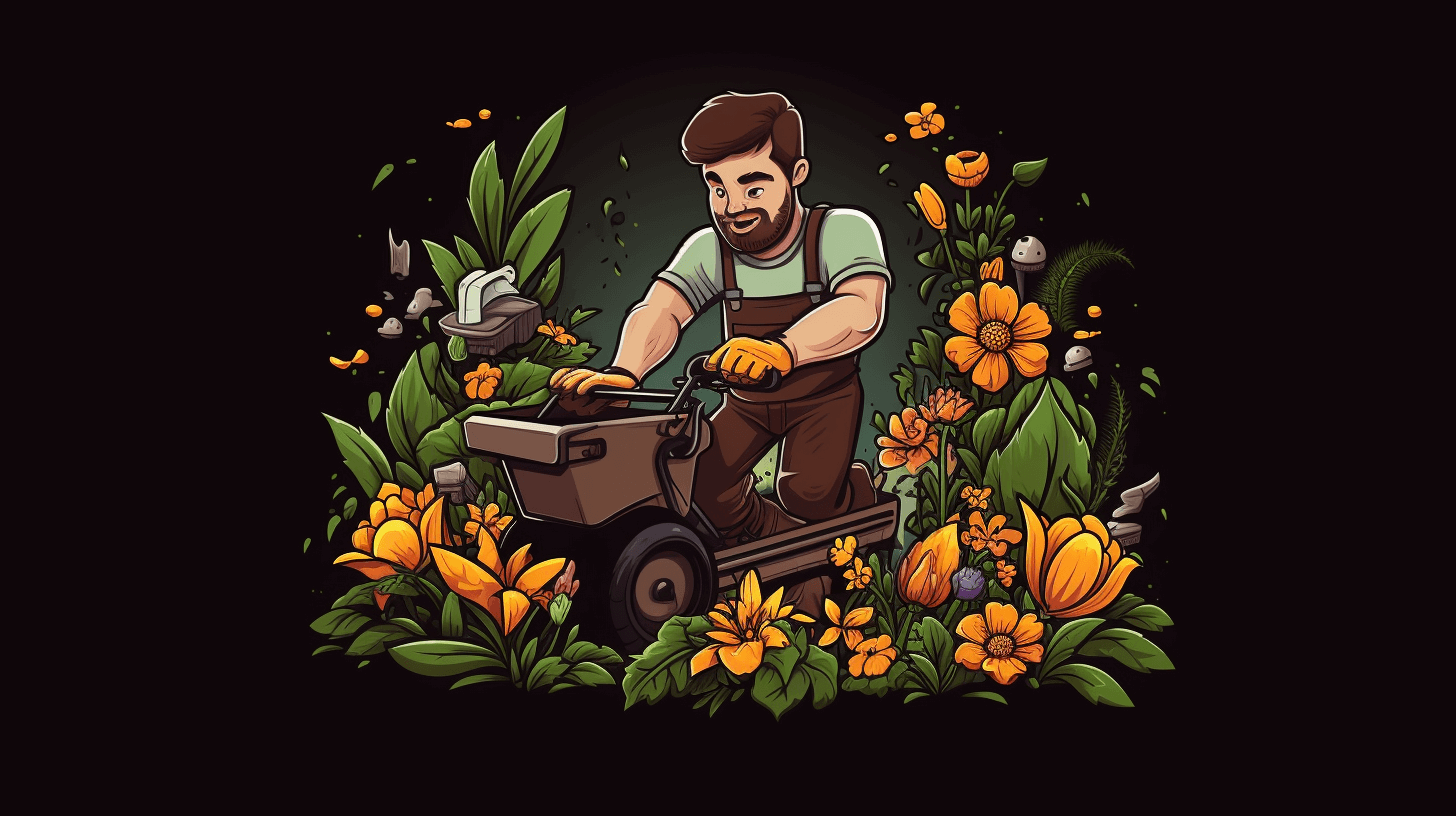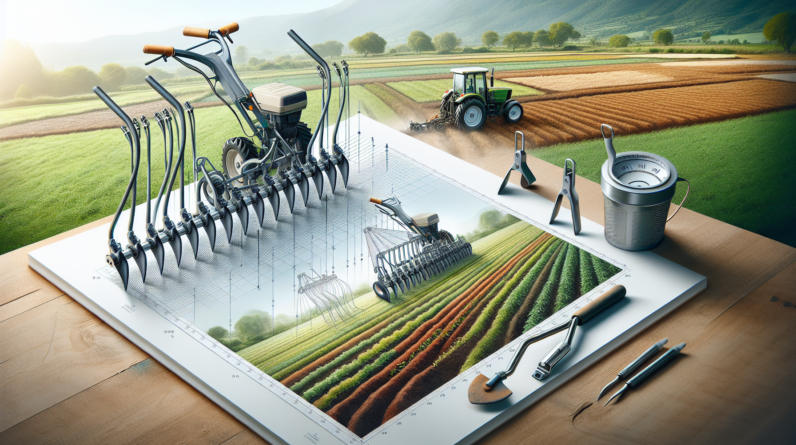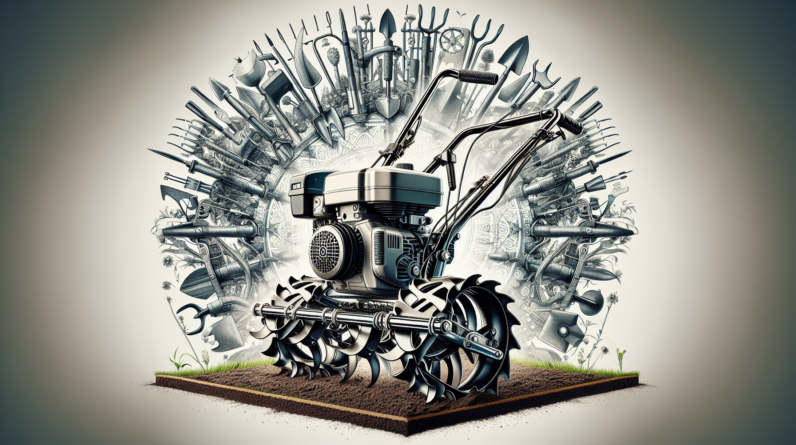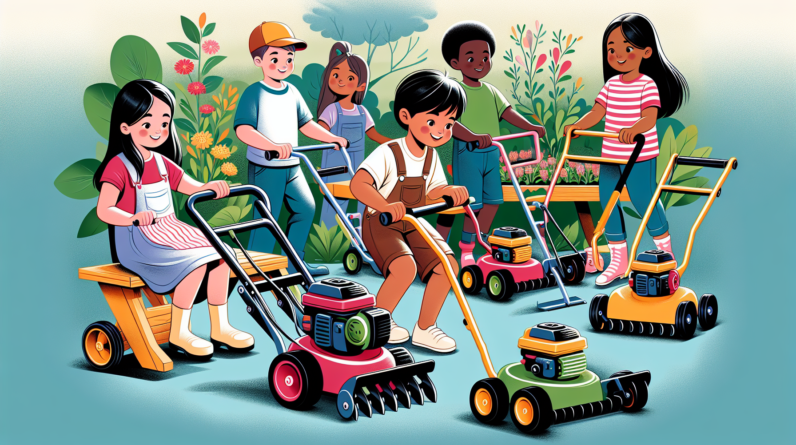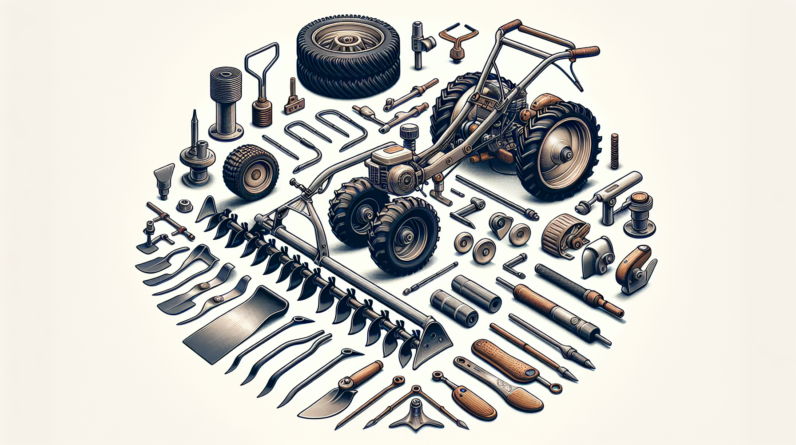Imagine having a garden that effortlessly thrives, with smoothly tilled soil and nutrient-rich beds ready for planting. With the invention of Single-Speed Garden Tillers, maintaining a flourishing garden has never been easier. These innovative machines take the guesswork out of tilling, offering a simple and efficient solution to transform your outdoor space. Say goodbye to the back-breaking labor of hand tilling, as these powerful tillers effortlessly break up compacted earth, loosening it to perfection. Whether you’re a seasoned gardener or a beginner, Single-Speed Garden Tillers are the ultimate tool for creating the garden of your dreams.
Overview of Single-Speed Garden Tillers
What are Single-Speed Garden Tillers?
Single-speed garden tillers are powerful gardening tools designed to break up compacted soil, preparing it for planting and creating an ideal environment for seeds to germinate. These machines feature a single speed setting, making them easy to operate and navigate through your garden.
Benefits of Single-Speed Garden Tillers
Single-speed garden tillers offer numerous benefits for gardeners of all skill levels. Firstly, their simplicity makes them user-friendly, even for beginners. They are lightweight, compact, and easy to maneuver, allowing you to till your garden efficiently without straining your muscles. Additionally, they are less expensive compared to their multi-speed counterparts, making them a cost-effective gardening solution.
Drawbacks of Single-Speed Garden Tillers
While single-speed garden tillers have many advantages, they also have a few drawbacks to consider. The most significant limitation is their lack of versatility. With only one speed option, they may not be suitable for heavy-duty tasks or varying soil types. Furthermore, their tilling depth and width may be limited compared to other tiller models, which can impact their effectiveness in larger gardens.
Key Features to Consider
Power Source
When choosing a single-speed garden tiller, one of the key features to consider is the power source. These tillers are available in both gas-powered and electric models. Gas-powered tillers offer more power and are ideal for larger gardens with denser soil. Electric tillers, on the other hand, are quieter, lightweight, and require less maintenance, making them suitable for small to medium-sized gardens.
Engine Type
The engine type is another important factor to consider when selecting a single-speed garden tiller. Gas-powered tillers typically have two types of engines: two-stroke and four-stroke. Two-stroke engines are lightweight, easy to start, and require a fuel-oil mixture. Four-stroke engines, on the other hand, are more fuel-efficient and have separate fuel and oil compartments. Electric tillers have a motor instead of an engine, offering a hassle-free and environmentally friendly option.
Tilling Width
The tilling width refers to the width of the area that the tiller can cover in a single pass. It is an essential feature to consider, as it determines how quickly you can till your garden. Single-speed garden tillers usually have a tilling width ranging from 9 to 18 inches. Smaller widths are suitable for narrow spaces or small gardens, while larger widths are more efficient for larger areas.
Tilling Depth
The tilling depth is the maximum depth the tiller can reach and loosen the soil. Single-speed garden tillers typically have an adjustable tilling depth ranging from 6 to 10 inches. It is crucial to select a tiller with a depth that suits your gardening needs, whether it is preparing the soil for annual plants or deeper tilling for perennial crops.
Weight and Maneuverability
Considering the weight and maneuverability of a single-speed garden tiller is important for ease of use. Lighter tillers are more convenient to push and maneuver, especially in tight spaces or around obstacles. Heavier tillers, although more stable, may require more effort to operate. Choose a tiller that strikes a balance between weight and stability based on the size of your garden and your physical capabilities.
Attachments and Accessories
Some single-speed garden tillers come with additional attachments and accessories, such as furrowers or dethatchers, that can enhance their functionality. Furrowers create precise seed planting rows, while dethatchers remove dead grass and debris from lawns. Consider the availability of these attachments and accessories when choosing a tiller, as they can expand the versatility and usefulness of your machine.
Choosing the Right Single-Speed Garden Tiller
Understanding Your Garden’s Needs
Before purchasing a single-speed garden tiller, it is crucial to assess your garden’s specific needs. Consider the size of your garden, the type of soil you have, and the frequency of tilling required. For smaller gardens with lighter soil, a compact and lightweight tiller may be sufficient. However, larger gardens or heavier soils may require a more powerful and robust model.
Determining Your Budget
Establishing a budget is another important step in choosing the right single-speed garden tiller. Since there are various tiller models available, with differing features and price points, knowing your budget can help narrow down your options. It is essential to strike a balance between quality, features, and affordability to ensure you get a tiller that meets your needs without breaking the bank.
Researching Different Brands and Models
Researching different brands and models of single-speed garden tillers is crucial to find a reliable and durable machine. Read product descriptions, specifications, and customer reviews to gather information about the performance, durability, and customer satisfaction of different brands and models. Look for reputable brands known for their quality and customer support to make an informed decision.
Reading Reviews and Customer Feedback
Reading reviews and customer feedback is an excellent way to gain insights into the real-world performance of single-speed garden tillers. Check online marketplaces, gardening forums, and review websites to see what other customers have to say about the tiller models you are considering. Pay attention to both positive and negative reviews to understand the potential pros and cons of each model.
Considering Long-Term Maintenance and Warranty
Consider the long-term maintenance and warranty options provided by the tiller manufacturer. Look for models that have accessible parts, easy maintenance requirements, and reliable customer support. Additionally, consider the warranty offered by the manufacturer to protect your investment. A longer warranty period is usually an indication of the manufacturer’s confidence in the tiller’s durability and performance.
Preparing Your Garden for Tilling
Clearing the Area
Before using a single-speed garden tiller, it is essential to clear the area of any debris, rocks, or large roots that could hinder the tiller’s performance or cause damage. Remove any obstacles, such as garden tools, furniture, or children’s toys, from the tilling area to ensure safe and efficient operation.
Inspecting the Soil
Inspecting the soil is crucial to determine its condition and make any necessary preparations before tilling. Check for areas with compacted soil or hard clumps that may require additional passes or manual loosening beforehand. Understanding the soil’s composition and condition will help you adjust the tilling depth and technique accordingly.
Removing Obstacles
In addition to removing rocks and larger roots, it is important to remove any underground obstacles, such as buried cables or pipes, to avoid damage. Use caution and consult utility maps, if necessary, to identify potential obstructions. Marking the location of underground utilities can help prevent accidents and costly repairs.
Ensuring Proper Safety Measures
Before tilling, ensure you follow proper safety measures to protect yourself and others. Wear appropriate protective gear, such as gloves and safety goggles, to shield yourself from debris and potential hazards. Familiarize yourself with the tiller’s safety features and operation manual to understand how to use the machine safely and effectively.
Using a Single-Speed Garden Tiller
Starting the Tiller
To start a single-speed garden tiller, follow the manufacturer’s instructions provided in the operation manual. Typically, you will need to ensure the tiller is on a flat surface, engage the safety features, and pull or switch on the engine ignition. Familiarize yourself with the tiller’s specific starting procedure to ensure a smooth and safe start.
Adjusting the Tilling Depth
Adjusting the tilling depth of a single-speed garden tiller is usually straightforward. Most models have a depth control mechanism that allows you to set the desired depth by adjusting a lever or dial. Take into account the condition of the soil and the depth requirements for your specific plants. Begin with a shallower setting and gradually increase the depth if necessary.
Applying Proper Tilling Technique
To achieve optimal results with a single-speed garden tiller, apply proper tilling technique. Start by making parallel passes over the tilling area, slightly overlapping each pass to ensure complete coverage. Move at a consistent pace, neither too fast nor too slow, to allow the tiller to work efficiently. Avoid forcing the tiller through the soil, as this can strain the machine and produce uneven results.
Navigating Different Terrain and Soil Types
Single-speed garden tillers are versatile machines that can handle various terrains and soil types. However, it is important to adjust your technique to accommodate different conditions. In softer soil, you may need to decrease the tilling depth to avoid tearing up the soil too much. In harder soil, you may need to make multiple passes or consider using additional steps, such as watering or pre-tilling, to ease the process.
Tips for Optimal Performance
Regular Maintenance and Cleaning
Maintaining and cleaning your single-speed garden tiller regularly is essential for optimal performance and longevity. Follow the manufacturer’s recommended maintenance schedule and instructions for oil changes, air filter cleaning/replacement, and other maintenance tasks. Remove any debris or soil buildup after each use to prevent clogs and ensure the tiller operates at its best.
Using the Right Fuel and Lubricants
Using the right fuel and lubricants is crucial for the proper functioning of a gas-powered single-speed garden tiller. Use the fuel recommended by the manufacturer, typically a mixture of gasoline and oil in the correct ratio for two-stroke engines. Lubricate moving parts as indicated in the operation manual, ensuring proper care and efficient operation of the tiller.
Proper Storage and Winterization
When the tilling season is over, proper storage and winterization of your single-speed garden tiller are important to maintain its condition. Follow the manufacturer’s instructions for storing the tiller, including draining fuel, cleaning the machine, and protecting it from moisture and extreme temperatures. Storing the tiller properly will extend its lifespan and ensure a smooth start in the following season.
Avoiding Overworking the Tiller
To prevent strain and potential damage to your single-speed garden tiller, avoid overworking the machine. Know the tiller’s limitations, such as its tilling width and depth, and plan your tilling sessions accordingly. If you have a large garden, divide the tilling into smaller sections and take breaks to prevent overheating. Overworking the tiller can cause premature wear and decrease its performance.
Safety Precautions
Wearing Protective Gear
When operating a single-speed garden tiller, it is essential to wear protective gear to prevent injuries. Wear safety goggles to protect your eyes from flying debris, gloves to shield your hands from blisters and cuts, and sturdy footwear to protect your feet. Additionally, consider wearing ear protection and long pants for further safety and comfort.
Understanding Tiller Operation Manual
Before using a single-speed garden tiller, thoroughly read and understand the operation manual provided by the manufacturer. The manual contains important information on the tiller’s specific features, starting procedure, safety precautions, and maintenance guidelines. Familiarize yourself with the tiller’s operation to ensure safe and efficient use.
Keeping Children and Pets at a Safe Distance
To prevent accidents or injuries, keep children and pets at a safe distance while operating a single-speed garden tiller. The tiller’s moving parts can be dangerous, and their curiosity may lead them to approach the machine. Create a designated safety zone and ensure that children and pets are supervised or safely away from the tilling area.
Using Caution Around Cables and Roots
Exercise caution when operating a single-speed garden tiller around cables, wires, and roots. Underground utilities such as gas lines and electrical cables can be damaged by the tiller’s blades, posing serious safety risks. Similarly, tree roots can become tangled and cause the tiller to jerk or tip over. Take the necessary precautions, such as marking cables and avoiding large roots, to prevent accidents and damage.
Common Troubleshooting Issues
Engine Starting Problems
If you encounter engine starting problems with your single-speed garden tiller, ensure that the fuel is fresh and properly mixed for gas-powered models. Clean or replace the spark plug, check the air filter, and ensure the fuel lines are free from blockages. If the issue persists, consult the troubleshooting section of the operation manual or seek assistance from a professional.
Clogging or Jamming
Clogging or jamming can occur when the tiller encounters particularly dense or wet soil. Clean any debris or soil buildup from the tines regularly during operation, ensuring they can rotate freely. In case of severe clogging or jamming, stop the tiller and turn off the engine. Clear any obstructions manually, avoiding any contact with the blades or rotating parts.
Uneven Tilling Results
If you notice uneven tilling results, it may be due to improper technique or the tiller’s settings. Ensure that the tilling depth is set correctly for the soil conditions, making adjustments as needed. Maintain a consistent speed and overlapping pattern during tilling to avoid skipped areas. If the problem persists, consult the operation manual for troubleshooting tips or consult a gardening expert.
Excessive Vibration or Noise
Excessive vibration or noise from the tiller can be indicative of an issue. Check for loose parts or nuts and bolts that may need tightening. Inspect the tines for balance and examine the engine or motor mounts for any damage or wear. If the problem persists or worsens, consult the manufacturer or a professional for further assistance.
Overheating or Motor Stalling
Overheating or motor stalling can occur if the single-speed garden tiller is overworked or if there are mechanical issues. Avoid forcing the tiller through tough or compacted soil, as it may overheat or stall. Allow the machine to cool down, check the oil and fuel levels, and clean any clogged air filters. If the problem persists, seek professional troubleshooting or maintenance.
Maintaining and Storing Your Tiller
Cleaning the Tiller After Use
After each use, clean your single-speed garden tiller thoroughly to remove any debris or soil buildup. Use a brush or hose to remove any caked-on dirt from the tines, frame, and other parts. Be sure to dry the tiller thoroughly before storage to prevent rust and corrosion.
Checking and Replacing Parts
Regularly check the condition of your single-speed garden tiller’s parts and replace any damaged or worn components. Inspect the tines, belts, and cables for signs of wear or damage. Ensure that all fasteners and nuts are tightened securely. Replace any parts that show significant wear or are no longer functioning properly to maintain the tiller’s performance.
Properly Storing the Tiller
Proper storage of your single-speed garden tiller is crucial to protect it from the elements and maintain its condition. Find a dry, sheltered area where it will not be exposed to extreme temperatures or moisture. If possible, store the tiller off the ground, using a shelf or hooks to prevent damage. Cover the tiller with a tarp or fitted cover to further protect it.
Seasonal Maintenance and Servicing
Perform seasonal maintenance and servicing on your single-speed garden tiller to optimize its performance and longevity. Before each tilling season, follow the manufacturer’s maintenance guidelines, such as changing the oil, inspecting the spark plug, and cleaning or replacing the air filter. Consider having the tiller professionally serviced if any issues or concerns arise during regular use.
Conclusion
In conclusion, single-speed garden tillers are valuable tools for any gardener looking to prepare their soil effectively. These tillers offer simplicity, maneuverability, and affordability, making them a popular choice among garden enthusiasts. When choosing a single-speed garden tiller, consider key features such as power source, engine type, tilling width and depth, weight, and attachments. Carefully assessing your garden’s needs, researching different brands, and reading customer reviews will help you make an informed decision. Remember to follow proper safety precautions, apply proper tilling techniques, and maintain and store your tiller correctly to ensure its optimal performance and longevity. With the right single-speed garden tiller, you can create the perfect environment for your plants to thrive and enjoy a productive and rewarding gardening experience.
